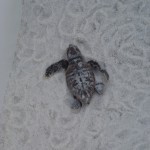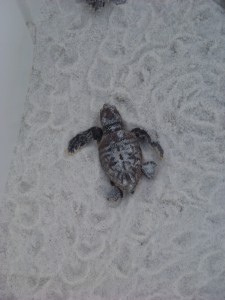
October 31st not only reminds all that the ghost and goblins are out and about, but that the sea turtle nesting season is complete for another year. These federally protected animals typically begin nesting in late April and continue into the month of October – but there is almost always someone late to the party…
What is neat about sea turtles is that their nesting beaches are usually always in the same general vicinity – meaning Pensacola Beach turtles are Pensacola Beach turtles… each year – and it is always great to see them come back. And this year, come back they did…
I have data collected by Gulf Islands National Seashore going back to 1996. The number of hatching nests on Escambia County beaches has ranged from a low of 8 (2005) to 52 in (2011); it has averaged around 25 hatching nests each year. This year was different…
This year, within the National Seashore, we had a total of 68 nests in Escambia County, 56 of which were on Santa Rosa Island. This is great news!
59 of the 68 nests hatched (87%) – which is also great news – typically only 10-20% of diamond back terrapin nests avoid predators. Most of the sea turtle nests lost this year were due to flooding from tropical storms in the Gulf. There was one nest between Pensacola Beach and Navarre Beach that was raided by a coyote and I am sure there were depredated nests all along the panhandle. But again, between 75-90% of terrapin nests are lost to raccoons, so the sea turtles had a good year. A recent report from southwest Florida states the same – a record nesting season for the Gulf coast.
However, there is still one problem lurking out there… disorientation…
Disorientation occurs when these successful hatchlings emerge from the sand and head the wrong way – typically towards artificial lights. Sea turtles are attracted to shortwave light (blues, greens, and white). Much of our artificial lighting falls into those wavelengths – and attract hatchlings. Since 1996 between 30 – 89% of Escambia County nests have shown signs of disorientation; the average is 49%. This year 63% of the Escambia County nests showed disorientation behavior. We are lucky that we have dedicated turtle watch volunteers to step in and correct these – but they cannot be there for all hatchings – we really need to alter our lighting. Longer wavelengths (yellow and red) do not attract most hatchlings, and therefore – are considered “turtle friendly”. Switching our outdoor lighting to these colors, reducing the illumination, lowering the elevation of the lighting, and shielding the light to direct it towards the ground all help reduce the disorientation problem.
Most panhandle counties have some form of coastal lighting ordinance to address this problem and problems with other wildlife. Ordinances vary some from county to county but the basics are the same; keep it long, keep it low, keep it shielded. Keep it long refers to the wavelength – usually less than 560nm (in the yellow/red portion of the spectrum). Keep low refers the height of the light fixture. If it can be placed at a lower height this is preferred, if not shielding the light source to direct down is required. We must also remember indoor lighting. This can be reduced by simply closing the curtains, moving lamps away from windows, or using tinted windows (if you are replacing yours). Who has to be wildlife friendly varies from county to county, so property owners should contact their Sea Grant Extension Agents if they have questions. There are funds available to help some complete this process and this to varies from county to county.
It’s been a great nesting season, let’s make it even better by reducing the amount of disoriented hatchlings.
Posted: November 5, 2016
Category: Natural Resources, Wildlife
Tags: Ended…, Nesting, Officially, Panhandle Outdoors, Season, Turtle


